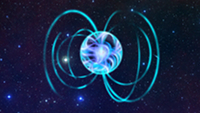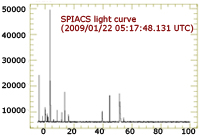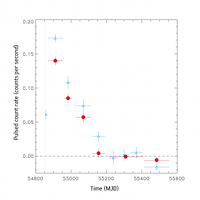Massive glitch moves magnetar modelling forward
12 April 2012
The chance discovery with ESA's INTEGRAL observatory, in 2004, of highly energetic X-rays emanating from a young neutron star with an extremely strong magnetic field, provided scientists with a challenge: to explain how these objects, also known as magnetars, produce such energetic non-thermal radiation. A new, comprehensive study of one particular magnetar, that was observed by several observatories over a period of 27 months, may provide the key to homing in on the processes at play in the extreme environments of these exotic stars.The term 'magnetar' was coined in the early 1990's to describe highly magnetised, rotating neutron stars that were proposed to explain the outbursts of low-energy gamma rays from a handful of neutron stars, known as Soft Gamma-ray Repeaters (SGRs). Since then, the magnetar family has expanded to include Anomalous X-ray Pulsars (AXPs), as astronomers now recognise that these too are powered by extraordinarily strong magnetic fields.
 |
|
Illustration of a magnetar. Credit: ESA |
Astronomers already know that the strong magnetic field of a magnetar acts like a brake, slowing down the rate at which the neutron star spins. Occasionally, this smooth deceleration is disrupted by a sudden increase in spin rate, known as a timing glitch. A 'star quake' near the magnetar's surface is thought to be responsible for the timing glitch and it is often followed by a large outburst of radiation – the emissions that are associated with SGRs and AXPs.
Until a chance encounter in 2004, the persistent emission from AXPs was assumed to be present only at low-energy X-rays. "Nobody saw any reason to look for emission from AXPs above 10 keV," says Wim Hermsen, also from SRON Netherlands Institute for Space Research, and a co-author of the study. "It was only because of the large field of view of INTEGRAL that we serendipitously detected an AXP emitting non-thermal emission that extended up to about 200 keV."
Following that discovery, theoreticians have been trying to explain this unexpected high-energy emission. "How this magnetic energy is transformed into non-thermal energetic X-rays is still strongly debated," says Hermsen. To help solve this mystery, the astronomers wanted to gather data in the low- and high-energy X-ray bands from a magnetar undergoing an outburst. Given the rarity of these objects – only about 20 have been discovered to date - and the unpredictable nature of these outbursts, this was quite a challenge.
 |
|
Some of the 200 short-duration bursts seen by INTEGRAL in January 2009. Credit: ESA |
Using data collected by INTEGRAL and by NASA's Swift and Rossi X-ray Timing Explorer satellites, Kuiper and his colleagues carried out a detailed study of how the emissions from the magnetar varied over a 27-month period.
Shortly after starting their analyses, the astronomers hit the jackpot when they discovered a very peculiar timing glitch – the most dramatic sudden change, by 70%, in the spin down of a magnetar that has ever been detected. This timing glitch was accompanied by an outburst of low- and high-energy X-rays.
High-energy unpulsed emission was detected immediately after the timing glitch, which suggests that the magnetar has a 'corona' of charged particles surrounding the neutron star. "Unlike ordinary pulsars, which only emit radiation along field lines originating from their poles, magnetars apparently have such strong fields that particles can be accelerated to produce X-rays all around the neutron star," says Hermsen.
 |
|
A delay in the appearance of pulsed emission is consistent with one particular model of magnetars. Image courtesy of Kuiper et al. |
In a model put forward in 2009 by Andrei Beloborodov from Columbia University in New York, USA, a star quake could twist the magnetic field lines that are anchored to a star's surface; these then gradually untwist, releasing magnetic energy and producing radiation. However, Beloborodov's model shows that the untwisting would occur in a peculiar way. Following a delay after the star quake, the untwisting would create a quasi-stable bundle of twisted field lines above the magnetic pole - this could explain the origin of the observed transient emission, say the astronomers.
"Basically, in this compact bundle of field lines, a mildly relativistic particle stream could boost the thermal X-rays from the surface to high energies, which would then be beamed along the magnetic dipole axis. After the maximum luminosity of this new high-energy pulse is reached, the energy output would decay to lower levels until a quasi-steady state is reached," says Hermsen. "This quasi-steady state also offers a promising explanation for the persistent X-ray emission from magnetars."
Although the fine details of what happens in the environs of a magnetar remain elusive, this new study has allowed astronomers to home in on possible mechanisms.
"INTEGRAL continues to play an important role in the study of magnetars, in part because of its unique capabilities to image targets which are emitting radiation with energies exceeding 200 keV," comments Christoph Winkler, ESA's INTEGRAL Project Scientist. "These findings provide a new piece in the very complex puzzle of understanding how high-energy emissions are generated by magnetars," concludes Winkler.
Notes for editors
Magnetars are pulsars (spinning neutron stars) characterised by rotation periods between 2 and 10 seconds, occasional episodes of extremely enhanced emission (about 10–100 times the usual value) and intense, short bursts of X-rays and gamma rays; these highly energetic events are presumed to be powered by an intense magnetic field( about 1014-1015 G).
The magnetar, 1E 1547.0-5408, is an Anomalous X-ray Pulsar with the fastest rotation period (2.069 seconds) yet observed for this type of object.
Bursting activity was detected from 1E 1547.0-5408 in October 2008 by NASA's SWIFT, Fermi, Rossi X-ray Timing Explorer (RXTE) and Chandra space telescopes. In January 2009 it was again observed to be active by Swift, Fermi, Konus-Wind (US/Russia), RHESSI (NASA), Suzaku (JAXA) and INTEGRAL (ESA).
The study described in this article is based on data from the INTEGRAL observatory and from the RXTE and Swift telescopes, and covers a period of 27 months, from the onset of bursting activities in October 2008 until January 2011.
INTEGRAL is an ESA project with instruments and science data centre funded by ESA Member States (especially the Principal Investigator countries: Denmark, France, Germany, Italy, Spain, Switzerland) and Poland, and with the participation of Russia and the USA.
Reference publication
Kuiper, L., Hermsen, W., den Hartog, P.R., Urama, J.O., 2012, Temporal and spectral evolution in X- and gamma-rays of magnetar 1E 1547.0-5408 since its October 2008 outburst: the discovery of a transient hard pulsed component after its January 2009 outburst, ApJ 748 133. doi: 10.1088/0004-637X/748/2/133Related publication
Beloborodov, A.M., 2009, Untwisting magnetospheres of neutron stars, ApJ, 703, 1044. doi: doi:10.1088/0004-637X/703/1/1044
Contacts
Lucien Kuiper
SRON-National Institute for Space Research
Utrecht, The Netherlands
Email: L.M.Kuiper sron.nl
sron.nl
Phone: +31 88 777 5875
Wim Hermsen
SRON-National Institute for Space Research
Utrecht, The Netherlands
and
Astronomical Institute Anton Pannekoek
University of Amsterdam, The Netherlands
Email: W.Hermsen sron.nl
sron.nl
Phone: +31 88 777 5871
Chris Winkler
INTEGRAL Project Scientist
Research and Scientific Support Department
Directorate of Science and Robotic Exploration
ESA, The Netherlands
Email: cwinkler rssd.esa.int
rssd.esa.int
Phone: +31 71 565 3591

